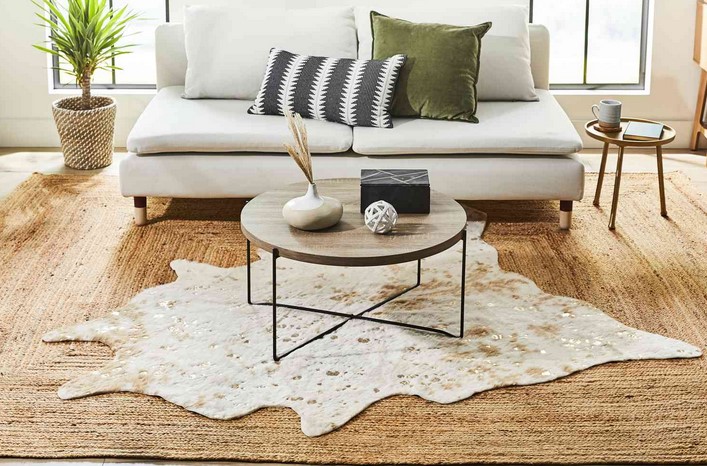
Layering area rugs is one of the most effective and stylish ways to add texture, warmth, and personality to your home. Whether you’re aiming to cozy up a space, introduce interesting design elements, or create a sophisticated focal point, area rug layering ideas can help you achieve the look you desire. By combining multiple rugs with different textures, sizes, and colors, you can create a visually dynamic and inviting atmosphere in any room. In this article, we will explore how to layer area rugs properly, providing practical tips and inspiration for achieving the perfect balance in your home décor.
1. The Importance of Layering Rugs
Layering area rugs has become an increasingly popular design trend for several good reasons. First, it allows for more flexibility in terms of style and pattern. Rugs are not only functional—they are also a key element in defining the aesthetic of a room. Layering enables you to introduce more colors, textures, and even cultural influences without overwhelming the space.
Another advantage of layering rugs is that it adds warmth and comfort, especially in larger or colder rooms. If your floors are made of hardwood, tile, or concrete, layering rugs can make a space feel cozier and more inviting. Additionally, rugs can help reduce noise levels, making the room quieter and more peaceful. Layering rugs also offers a practical solution for protecting your flooring while simultaneously enhancing your room’s style.
2. Choosing the Right Rugs for Layering
When layering area rugs, it’s important to carefully choose pieces that complement one another in terms of size, texture, color, and pattern. Below are some tips for selecting the right rugs to layer:
A. Consider Size and Shape
The size and shape of your rugs should be selected based on the area you want to cover. A large, foundational rug, such as a 9×12 or 8×10, can act as the base layer, while smaller accent rugs can be layered on top to add texture and interest. Be mindful of the size ratio between the two rugs to ensure they work together harmoniously. Typically, the base rug should cover most of the floor area, while the layered rug should be smaller and placed strategically to highlight specific areas of the room.
Rectangular rugs are most commonly used as the base rug, but other shapes, such as round or square rugs, can also be layered for visual contrast. A round rug layered over a rectangular rug, for instance, can add a sense of playfulness and balance to the space.
B. Mix Different Textures
One of the key advantages of layering rugs is the opportunity to mix different textures. For example, you might layer a plush wool rug on top of a flat-woven jute rug to create a combination of softness and durability. Mixing textures can help create a multi-dimensional effect and enhance the tactile experience of a room. Consider pairing luxurious silk or velvet rugs with coarser, natural fiber rugs like sisal or jute for a rich and varied look.
C. Play with Color and Pattern
Color and pattern are where you can get creative with your area rug layering ideas. Start by choosing a dominant color or theme for your space. Then, select a base rug that fits within that palette. Once you’ve established the main color, you can layer in smaller rugs with contrasting or complementary colors.
For instance, if you’re working with a neutral-toned room, layering rugs with vibrant patterns or bold colors can make the space feel more dynamic and inviting. On the other hand, if your room already has a lot of visual interest, choose more subdued rugs with minimal patterns that won’t compete with the rest of the décor. Patterns such as stripes, florals, or geometric shapes can add personality to the room without overwhelming the senses.
3. Tips for Layering Rugs in Different Rooms
A. Living Room Layering Ideas
In the living room, layering area rugs can create a warm and inviting atmosphere, especially in larger spaces with open floor plans. A large, neutral-colored rug can anchor the furniture, while smaller, decorative rugs can be layered over it to add texture and interest. For instance, you can place a plush shag rug over a woven jute rug to introduce softness and comfort without sacrificing the natural texture beneath.
When layering in the living room, make sure the rugs align with the furniture layout. You don’t want to cover too much of the floor under the seating area, as it may make the room feel crowded. The base rug should cover the area where the front legs of the furniture will rest, while the top layer can be placed in the center or slightly off-center for an asymmetrical effect.
B. Bedroom Rug Layering Ideas
Layering area rugs in the bedroom is a great way to add warmth and comfort underfoot, especially if you have hardwood or tile floors. Start with a large rug that covers most of the floor, ensuring it fits well under the bed and extends a few inches beyond the edges. A plush, soft rug can create a cozy, inviting atmosphere as you get in and out of bed.
You can then layer a smaller rug at the foot of the bed or next to it, depending on your space. A layered rug with bold patterns or contrasting colors can serve as a focal point and add interest to the room. Be mindful of scale when layering in the bedroom—avoid overcrowding the floor with too many rugs. The goal is to create balance and cohesion with the rugs complementing the rest of the décor.
C. Kitchen and Dining Room Rug Layering Ideas
Layering rugs in the kitchen or dining room can be a bit trickier, but it can still add a lot of personality and comfort to the space. In the kitchen, you can layer smaller rugs or runners in front of the sink or stove, placing them over a larger rug that covers the floor in the center. For a dining room, layer a decorative rug under the dining table and add a smaller rug beneath the seating area to create a cozy, grounded feel.
In both spaces, durability is important. Look for rugs made from materials that can withstand heavy foot traffic and are easy to clean. Natural fiber rugs or rugs with low-pile fabrics tend to work well in kitchens and dining areas, offering both practicality and aesthetic appeal.
Area rug layering ideas are an excellent way to bring texture, warmth, and visual interest to your home. Whether you’re working with a spacious living room, a cozy bedroom, or a functional kitchen, layering rugs provides endless opportunities to enhance your space with depth and character. By thoughtfully considering size, shape, texture, and color, you can create an inviting atmosphere that is both functional and stylish. With the right combination of rugs, you can transform your home into a cozy, well-designed haven. Start exploring area rug layering ideas today to elevate your décor and add a personalized touch to your living spaces.
